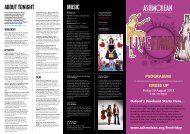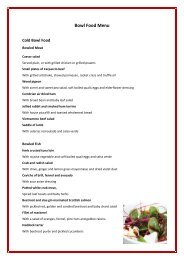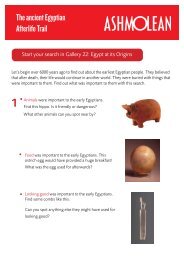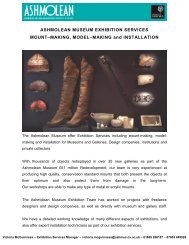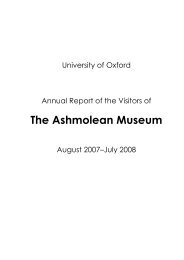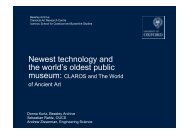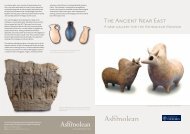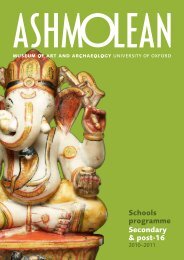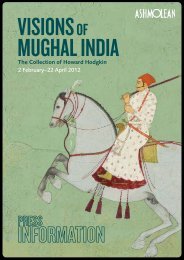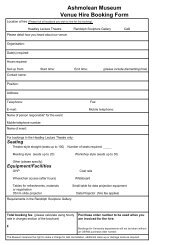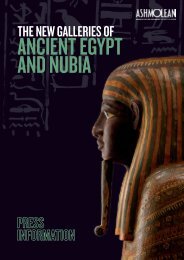The Bronze Age: Canaan - The Ashmolean Museum
The Bronze Age: Canaan - The Ashmolean Museum
The Bronze Age: Canaan - The Ashmolean Museum
Create successful ePaper yourself
Turn your PDF publications into a flip-book with our unique Google optimized e-Paper software.
ANCIENT NEAR EASTERN TERRACOTTAS<br />
do not have any attributes or special headdresses to indicate divinity. Van der Toorn (1998, 94) who, on<br />
balance, interprets the <strong>Canaan</strong>ite plaques as “reflections of official cult images or symbols, used outside<br />
the cult for devotional and prophylactic purposes”, is at one with Pinch over the function of such images<br />
in so far as he draws attention to the way in which biblical and extra-biblical Hebrew texts reveal that<br />
matters of fertility and child-birth were of no less concern in <strong>Canaan</strong> and Israel (as in Genesis 30: 14–16<br />
and the Song of Songs 7:14).<br />
At Tell ed-Duweir (Lachish) a potter’s workshop situated in a cave, dated to Late <strong>Bronze</strong> II, provides a<br />
rare demonstration that such mouldmade figurines were made by some potters at least along with their<br />
standard ceramic repertory. <strong>The</strong> relevant finds (Tufnell 1958, 90, pl. 49:1–5) included: two ‘Astarte’<br />
plaques; part of a mould for one; and “the lower half of an unbaked figurine, the details of which did not<br />
turn out too plainly from the mould. <strong>The</strong> same may be said for the upper part of another plaque”.<br />
Although apparently commonest in the Late <strong>Bronze</strong> <strong>Age</strong>, plaque figurines survived into Iron <strong>Age</strong> II<br />
(c.1050–750 B.C.), when they were “very different from their <strong>Bronze</strong> <strong>Age</strong> predecessors” (Kletter 1996,<br />
34ff.) (see below).<br />
301. Bovid (); handmodelled; baked clay; buff core with creamslip; hollow-bodied<br />
animal, legs missing and rump damaged; the hollow head is like a spout opening<br />
at the mouth; the eyes and nose are applied in clay with deeply incised pupils<br />
and nostrils; horns broken off.<br />
AN1912.622 (acquired with no. 300 above). L: 10.8cm.<br />
Macalister (1912, pl. CXXIV–VI) illustrated many fragments of hollow,<br />
handmade animal figurines, primarily their heads, sufficiently like this one to<br />
suggest that the reported source of it is plausible, even if they offer no clear guide<br />
to its date. Many animal-head fragments similar to this are spouts from vessels, whereas this object has<br />
no aperture other than the open mouth. In the absence of close published parallels it may only be broadly<br />
dated to the later <strong>Bronze</strong> or early Iron <strong>Age</strong>.<br />
(ii)<br />
Tell ed-Duweir (Lachish)<br />
Tell ed-Duweir, ancient Lachish, is situated in the low hills west of Hebron. It was first systematically<br />
excavated in 1932–1938 by the Wellcome-Marston Expedition, directed by Starkey. Excavation of the<br />
main settlement only reached the Iron <strong>Age</strong> II occupation levels. Evidence for earlier periods came from<br />
caves and tombs, from a section cut into the mound and from surface clearances. Tomb (or Cave) 4004,<br />
whence came no. 301A, consisted of three chambers, primarily used for burials in Middle <strong>Bronze</strong> IIC to<br />
Late <strong>Bronze</strong> II, and then re-used late in that period (cf. Tufnell 1958, 281). It may originally have been cut<br />
for use as an olive press. Tufnell (1958, 282) described it thus: “the amount and variety of the funerary<br />
equipment and the concentration of the shattered offerings into a depth of only 30cms. suggests that the<br />
cave was used as a charnel house. <strong>The</strong> offerings were not necessarily exceptional among the community<br />
of Lachish, but conditions have conspired to preserve them in tenacious mud within a deep and sheltered<br />
cave”. <strong>The</strong> <strong>Ashmolean</strong> <strong>Museum</strong> received an allocation of finds which came to England following the<br />
official division; but only after they had been prepared for publication following World War II. Renewed<br />
excavations at the site were directed by Ussishkin from 1973.<br />
301A. Nude female plaque; mouldmade in high relief; dark blue glass; broken plinth; arms bent;<br />
hands clasping breasts; rather pronounced abdomen, possibly indicating pregnancy; the<br />
surface has deteriorated since excavation and the colour has changed; thread-hole at the<br />
shoulder for use as a pendant.<br />
AN1955.501; from tomb 4004 at Tell ed-Duweir (Lachish); fifteenth century B.C.; L: 5.5cm.<br />
cf. Tufnell 1958, 33ff., pl. 27:3; Moorey 1969, pl. 12a; Barag 1970, 188–91, 199; Kühne 1969,<br />
311, fig. 5; Winter 1983, fig. 27.<br />
-190-




